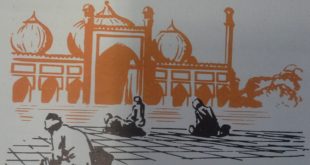Thirteen and a half centuries ago a new religion began in Arabia. Today millions of people are followers of this religion. It is called Islam and its followers, Moslems. All their lives long, Moslems must pray, in ways clearly prescribed, five times every day. No ordinary event must be allowed to interfere with these moments of prayer. Moslems must learn to recite their creed — a long statement of their religious belief. For one month each year they must fast all of every day from sunrise to sunset. They must give generously to charity. They should, if at all possible, go at least once during their lives to the holy city of Mecca, where Mohammed, the founder of Islam, began this new religion. People of other faiths are forbidden to enter Mecca. A few miles outside of Mecca, Moslems must change to pilgrims’ dress and proceed barefoot when they enter this city, high up in west-central Arabia. Mohammed and his first followers were Arabs. Arab merchants and Arab warriors, influenced the history of other peoples. United by loyalty to their religious faith, Arabs created a large empire. Arab rulers occupied positions of great influence and were keenly interested in advancing learning. How did all this come about? 1. How did the religion of Mohammed create a powerful Moslem world? 2. What kind of civilization developed in the Moslem world? 1. How did the Religion of Mohammed Create a Powerful Moslem World? Arab civilization started later than other great civilizations. The story of the Moslem world began about 600 A.D. in Arabia, a huge peninsula covered for the most part with burning desert. Arabia is separated from Africa by the Red Sea and from Iran (Persia) by the Persian Gulf. To the north and west of the Arabian peninsula is the …
Read More »The Renaissance in the North and Spain 1400 – 1598
Through the bustling market-towns of the Low Countries passed the traders, goods and gold of all Europe. Here the luxuries of Asia — spices‚ silks, jewels and perfumes — were exchanged for the practical products of the North — woolen cloth and utensils of iron and copper and wood. In shops and inns, wily Italian shippers and bankers bargained with the solemn, solid merchants from Germany and Flanders — and made the profits that built the Renaissance cities of Italy. In tall-spired cathedrals, in palaces, guildhalls and universities, wandering Italian artists discovered works of art and scholarship as great as any they had known at home. The men of the North had needed no outsiders to teach them about money-making or magnificence. Long before the Renaissance spread across Europe from Italy, they had turned to business, formed the guilds, grown rich and invested their gold in displays of splendour. Flanders was the center of a great cloth-making industry. Germany was the home of expert craftsmen—armourers, goldsmiths and engravers. In Haarlem in the Low Countries, a jack-of-all-trades named Laurent Coster had first thought of using movable carved letters to form words and sentences from which pages could be printed. About 1440, Johann Gutenberg and his assistant Peter Schoeffer had put Coster’s idea to use, made the first printed books and brought about a revolution in learning that changed the history of the world. The northern artists also were inventive and their guildsman patrons kept them as busy as the artists of Italy. Of course, their tastes were not Italian and their paintings and statues, like their ideas, were very different from those in Florence, Milan and Rome. When Masaccio was first teaching the Florentines how to paint figures that “stood on their feet,” the wool merchants of Flanders were buying paintings …
Read More »

